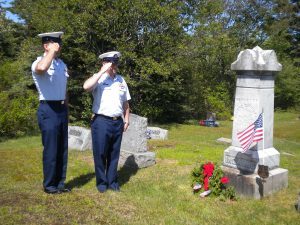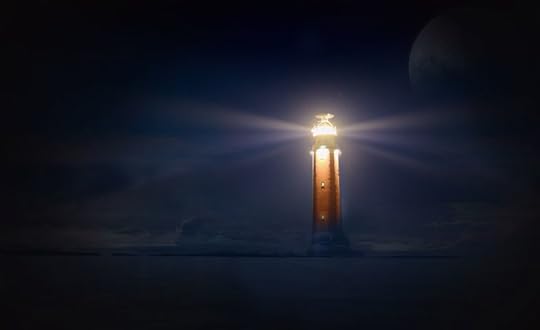Marilyn Turk's Blog, page 6
April 16, 2020
How Writers Cope during the Pandemic
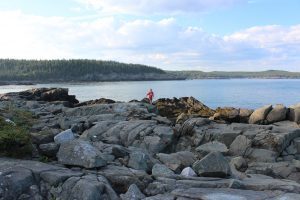
Social distancing on Little River Island in Maine, photo by Chuck Turk
Appointments and meetings have been cancelled. Sports events have been cancelled. Vacations have been cancelled. Even going to church has been cancelled. The government tells us to stay at home to prevent the spread of the disease.
So now, we writers are stuck home with no place to go. What a great opportunity to write! Unlimited time, the type of thing writers dream for, is in our hands. So why am I not writing? Why am I doing other things around the house instead?
I’ve read enough blogs and posts to know I’m not the only writer with this problem now. Despite the lack of social interaction this isolation has caused, the overshadowing threat of the virus looms, perpetuated by the news media. Even if I don’t read or hear about the virus all day, just the knowledge that the threat hangs over us like a giant monster, waiting to consume us is enough of a distraction to stall my momentum.
Perusing social media, I’ve gathered a list of healthy ways other writers cope with this monster. Maybe you’ll see some you’d like to try as well.
Pray – When life is out of our control, we go to someone who has more power than we do.
Get comfortable – really? With enough jokes about wearing real pants, I think we’ve figured that one out.
Give yourself grace – Don’t beat yourself up is you don’t feel like writing. Allow yourself to take a break without guilt.
Grieve, then move on – have you had a good cry lately? We’ve lost a lot – freedom, maybe jobs, our ‘normal,’ not to mention human life. It’s best to let it out and stuff it in.
Find a new hobby. Maybe it’s time for that, “One day when I have time, I’ll…”
Studies show that laughter releases endorphins in your body that in turn, strengthen your immune system, elevate your mood, diminish pain, and protect you from the damaging effects of stress. Author Anne Mateer and her husband found that watching old comedy movies helped ease their anxiety.
Music – Play music – rock, classical, jazz, easy-listening—try different types.
Chocolate – good for any occasion, right?
Limit your exposure to the news. Did you ever learn the children’s tune that says, “Be careful little ears what you hear, or be careful little ears what you see?” Too much exposure to negative input can feed depression.
Let it go, anger, that is. You may be angry about what’s happening and looking for someone to blame. I’m appalled by all the self-appointed police who want to report everyone who’s not obeying the stay-at-home, stay-away mandate. Just as laughter is healthy for you. Anger is bad for you. Anger can cause headaches, digestion problems, such as abdominal pain, insomnia increased anxiety, depression, high blood pressure, skin problems, heart attack, and stroke.
Play games. When was the last time you got those board games out? Instead of watching TV nonstop, do something with your hands and spend time with the others in your household.
Put puzzles together. Not only do they engage the hands, they provide a level of satisfaction.
Go for a walk. Put on your mask if you have to, but get some exercise outside and engage your whole body.
Many writers have a hard time fitting in reading other writers’ work, but now might be the time. Not only does it help to support your fellow writer, you learn to appreciate other writing styles or genres.
Sit in the sun. We know that sunlight increases the body’s production of vitamin D, but it also increases serotonin in the brain which also lifts your mood and reduces stress. Even five minutes in the sun can boost your spirits.
Phone a friend or Face-time with them. Talking to someone else in the ‘same boat’ helps, since we’re not alone in this situation.
Have you tried any of these activities? Is there something that has helped you cope during this time? I’d love to hear about it.
“Rejoice in the Lord always. I will say it again: Rejoice! Let your gentleness be evident to all. The Lord is near. Do not be anxious about anything, but in every situation, by prayer and petition, with thanksgiving, present your requests to God. And the peace of God, which transcends all understanding, will guard your hearts and your minds in Christ Jesus.
Finally, brothers and sisters, whatever is true, whatever is noble, whatever is right, whatever is pure, whatever is lovely, whatever is admirable—if anything is excellent or praiseworthy—think about such things.Whatever you have learned or received or heard from me, or seen in me—put it into practice. And the God of peace will be with you.” Philippians 4:4-9
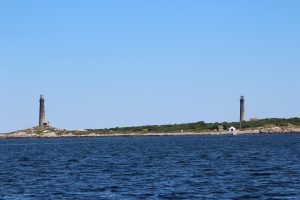
Thacher Island, Twin Lights, Rockport, MA, photo by Chuck Turk
March 8, 2020
The Little Lady that Saved the Lighthouse
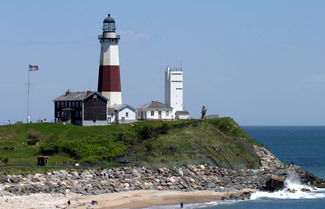
Montauk Point Lighthouse, photo courtesy lighthousefriends.com.
If you visit Montauk Point Lighthouse on the end of Long Island, New York, you’ll find it hard to believe the lighthouse was almost abandoned, either to be destroyed or allowed to fall into the sea by the encroaching waves.
But that is exactly what almost happened. The 110-foot tower, commissioned by George Washington in 1792, was constructed in 1796 and sat 297 feet from the edge of the cliff. By 1967, however, the sturdy tower that Washington predicted would last 200 years, was 55 feet from the edge as a result of wind and wave erosion at the rate of two feet a year. The lighthouse was doomed to fall into the Atlantic Ocean.

Montauk Point Lighthouse, 1961, photo courtesy U.S. Coast Guard
During this same period of time, the U.S. Coast Guard was de-manning nearly two-thirds of lighthouses along the eastern seaboard for budgetary reasons. These old lighthouses could be replaced by new steel towers with lights on top, operated from a nearby Coast Guard station by remote control. The situation of the Montauk Lighthouse could be resolved the same way. The order was given to find a new site farther inland on which to build the replacement tower, then abandon the Montauk Lighthouse. Before allowing the elements to eventually take the old lighthouse, however, the Coast Guard planned to blow it up to prevent vandalism and insurance problems, a practice that had been carried out at other lighthouses deemed unnecessary.
Discovering this plan, local newspaper writer Dan Rattiner, wrote an article about the plans for the lighthouse and garnered public support in favor of saving it. In 1969, the Coast Guard rescinded their order and the lighthouse was saved. But no one knew what to do about the erosion.
Shortly afterwards, a small retired woman named Giorgina Reid and her husband Donald appeared in the writer’s office, and Mrs. Reid announced they had a plan to stop the erosion. According to the couple, they had faced the same problem after buying a cottage near the sea. But when Giorgina read about how Japanese had used grasses and terraced land to stop erosion, she decided to try the method on their own property which proved successful. Mrs. Reid believed the same method could be used to save the cliff at Montauk.
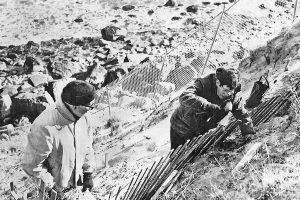
Giorgina Reid and her husband working on cliff face
Nothing else had worked, so the four-foot, ten inch woman was given the go-ahead to start working at Montauk. For fifteen years, the Reids and a few student volunteers from Stony Brook University went to the lighthouse, built terraces in the bank and planted them with wild grasses to hold the dirt in place. The huge cliff face was eighty feet high and a quarter mile in length. Concentrating on one 10 by 20-foot patch at a time, the Reids succeeded in stabilizing the soil, refusing the help of the Coast Guard during the process, except for furnishing supplies and hauling things up and down.
Since then, the soil has held, the Montauk Lighthouse still stands, and the Coast Guard has taken over the protection of the cliff face now that the Reids have passed away. There’s a special room in the old keepers’ quarters, the Giorgina Reid Room of the Montauk Lighthouse Museum, run by the Montauk Historical Society.
Giorgina Reid’s story reminds me of the story of David and Goliath in the Bible, in the book of 1 Samuel, chapter 17. When the whole army had given up on defeating the giant Goliath, the little shepherd boy stepped up and volunteered to go against the enormous enemy. When no one believed he would succeed, he did. When others saw him as too small to handle such a big problem, he did. He rejected a soldier’s armor and weapons, choosing instead the gifts God had given him. And when others believed he would fail, he believed he would succeed. Like Mrs. Reid’s past experience proved to be successful, David’s past experience as a shepherd proved his faith in God’s ability to succeed.
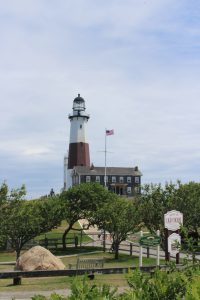
Montauk Lighthouse, photo by Chuck Turk
“Everything is possible for one who believes.” Mark 9:23
November 19, 2019
Honoring Our Lighthouse Ancestors
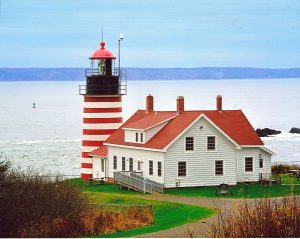
West Quoddy Head Lighthouse, Maine, photo by Laura Timberman
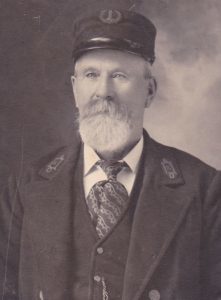
Ebenezer Wormel, keeper at West Quoddy 1849-1851, recently honored
Today’s post was written by Special Guest Timothy Harrison, Editor of Lighthouse Digest
For almost all of modern history the men and women who have served in our nation’s military forces have been honored with veteran’s markers at their grave sites at community cemeteries across the United States.
However, the men and women who once served in the United States Lighthouse Service were never given this honor, even though the duties of a lighthouse keeper were no different after the organization was taken over in 1939 by the United States Coast Guard. They always guarded our coasts, protected mariners from danger, and many died in the line of duty due to the perils of the job.
This oversight of veteran recognition was probably because the U.S. Lighthouse Service was considered a civilian organization, even though its male personnel wore uniforms and it was managed under many of the same rules, regulations, and guidelines used by other military branches of the government.
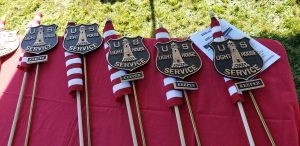
Lighthouse Keeper memorial markers
Starting in 2011, in an attempt to rectify this situation, Lighthouse Digest became the first organization in the nation to start placing United States Lighthouse Service memorial markers at the gravesites of those who served in the Lighthouse Service as lighthouse keepers, crewman on lighthouse tenders and lightships, and in various other positions of the U.S. Lighthouse Service.
Since then Lighthouse Digest has placed Lighthouse Service memorial markers at the graves of dozens of Maine’s lighthouse keepers, as well as lighthouse keepers in Louisiana and the Pacific Northwest. Lighthouse Digest did this in hopes that other lighthouse groups, as well as private individuals, would follow their lead, but the process has been slow. So, our motto in doing this has always been, “If we don’t do it, who will?”
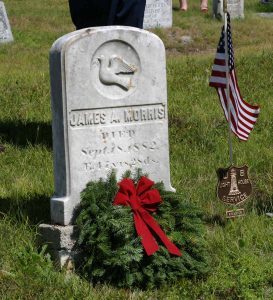 There are thousands of keepers’ graves yet to be marked. To help make a difference and contribute to the Lighthouse Grave Marker program go to https://www.gofundme.com/USLHSgraves
There are thousands of keepers’ graves yet to be marked. To help make a difference and contribute to the Lighthouse Grave Marker program go to https://www.gofundme.com/USLHSgraves
A pillar of fire by night to give them light that they might travel.
Exodus 13:21
October 31, 2019
What’s Good about being a Ghost?
What’s Good about being a Ghost? (ghostwriter)
There are times in my writing career when I’m asked to ghostwrite a story, that is, write someone else’s story, where they get the byline and I don’t. As a writer who likes to take advantage of any opportunity I can, I usually accept the assignment.
Some of my friends wonder why I would write something that doesn’t have my name attached. I asked myself the same thing. In this world of self-promotion, it goes against the grain of marketing to do something without getting the attention.
After I ghostwrote my first story, I felt the need to tell everyone that it was really I, not the person whose name appeared, who wrote the story. But with subsequent ghostwritten work, I was more comfortable with my name not being on the piece.
So what are the reasons to do ghostwriting? Here are mine:
The story is not my story. It’s someone else’s.
I was asked because I’m a writer, and the person whose story it is, isn’t a writer.
I get paid to do it.
It keeps me humble.
The last reason is perhaps most important because I believe God wants me to use my talents to honor Him, not myself. I can write books and blogs and draw attention to what I did, but that leads to pride, and God hates pride. I can get caught up in looking at reviews (what people think about my writing), how many hits my blog gets, (am I popular?) or sales (do people want my books?), which draws my focus to myself and away from God.
One of my favorite Bible teachers and inspirational mentors, Liz Curtis Higgs, once said that Christians shouldn’t worry about their marketing platform because God has control of that, not us. She didn’t say we shouldn’t do any marketing—our publishers require us to spread the word about our books since they’ve invested in our products. What she said was not to worry about it, not obsess over it.
So how do we balance our writing for God and our need to be recognized for it? We make sure He’s included in the process from the beginning, with prayer, to the end, with thanksgiving and praise. I love how the King James Version expresses Psalms 100, verse 3: “Know ye, that the Lord, He is God. It is He who has made us and not we ourselves.” God knows us, He knows what gifts we’ve been given, and He knows what we do with them.
As long as He knows what I’m doing, I don’t mind being a ghost.
Whatever you do, work at it with all your heart, as working for the Lord, not for human masters, since you know that you will receive an inheritance from the Lord as a reward. It is the Lord Christ you are serving. Colossians 3:23-24, NIV
October 18, 2019
Rescued by a Buoy*
I’d like to welcome a fellow lighthouse lady, Elinor DeWire, who wrote this week’s post. Elinor is a lighthouse expert and enthusiast, and so we have the latter in common. Hope you enjoy her post! Leave a comment and let us know.
To the landsman, buoys are homely, rotund objects bobbing awkwardly in channels and harbors, making a monotonous racket with their ceaseless clanks, gongs, and whistles. Their colors and shapes give them the appearance of castaway circus clowns, but these important navigational aids perform a critical service at sea as the road signs of the waterways.
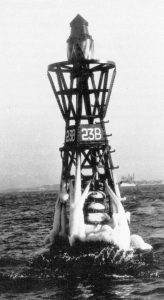 No one would argue that buoys save lives, but sometimes they serve us in unexpected ways. A lighthouse family at Timbalier Bay, Louisiana was saved by an iron can buoy not far from their sea-swept home in 1867. The terrible March 29 hurricane of that year washed away the tall, brick lighthouse, then scoured clean the low sandy island on which it stood and left it submerged under a high storm tide. The castaway lightkeeper, his wife, and daughter “faithfully performed their duties, barely escaping with their lives. Awash in the storm surge, they clung to each other as the tide fortuitously carried them to the trusted buoy. They crawled inside and rode out the storm, remaining on board for several days until rescued by a passing ship.
No one would argue that buoys save lives, but sometimes they serve us in unexpected ways. A lighthouse family at Timbalier Bay, Louisiana was saved by an iron can buoy not far from their sea-swept home in 1867. The terrible March 29 hurricane of that year washed away the tall, brick lighthouse, then scoured clean the low sandy island on which it stood and left it submerged under a high storm tide. The castaway lightkeeper, his wife, and daughter “faithfully performed their duties, barely escaping with their lives. Awash in the storm surge, they clung to each other as the tide fortuitously carried them to the trusted buoy. They crawled inside and rode out the storm, remaining on board for several days until rescued by a passing ship.
More compelling is the 27-hour ordeal of fisherman, Robert Curtis, who owes his life to the Bay Ledge Buoy, located six miles south of Carver’s Harbor, Maine. Curtis had gone clamming on a clear, cold Sunday morning in January 1984, motoring out of Rockland in his 15-foot boat, headed for the rich clam beds at Kent Cove. Though the weather forecast called for a sunny and mild day, the sky soon took on a drab gray pallor. Before long, Curtis was caught in an unexpected snow squall.
The wind picked up to 35 knots, and waves began swamping the little boat. Curtis bailed furiously and tried to steer for the nearest land. He motored aimlessly for more than an hour, his boat sloshing and bouncing like a toy in a bathtub. By noon the temperature had dropped into the single digits, and Curtis was twelve miles off course. His hands were numb, and ice encrusted his face and hair, but help was in sight. Ahead of him bobbed the Bay Ledge Buoy with a big number 2 painted on its top.
Though Coast Guard regulations prohibit climbing on a buoy or using it as a mooring, Curtis knew he had to tie up to the buoy or risk being blown out to sea. Carefully, he eased alongside, but just as his hand grasped the buoy, the boat was swept from under him. He scrambled onto the bobbing can, wet and chilled, and watched his boat slowly putter away.
Waves drenched him, and his hands began to freeze to the metal. Wisely, he removed his belt and attached it to the buoy so that he would have a strap to hold. His down jacket became a sit-upon that kept him from freezing fast to the ice-shrouded buoy. Curtis knew it was important to move about, so he began walking round and round on the buoy holding tightly to the belt.
When night came and near unbearable cold set in, he tore off bits of his rubber boots and burned them with a Bic lighter to warm his hands and face. There was little heat generated, but the simple act gave him hope and “buoyed” him throught the long, frigid night.
A helicopter passed over in the darkness, sweeping a spotlight, but though Curtis screamed and waved, he was not sighted. A friend had reported him missing, and crews from Coast Guard stations in Rockland, Portland, and Cape Cod were combing the waters by aircraft and rescue cutter. Local boaters turned out to look for Curtis, and even a 110-foot tug out of Portland joined the search.
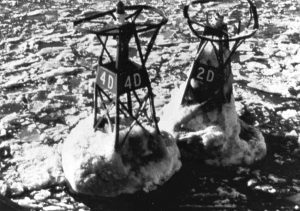 At dawn Curtis desperately searched the horizon for signs of rescue, but saw none. He was convinced death awaited him on the lonely buoy. Around 2 PM, he heard engines approaching and spotted the Point Hannon out of Jonesport. The crew were amazed to find Curtis alive and cheering energetically as they pulled him off the frozen buoy. He was taken to a Bangor hospital suffering from minor frostbite of his hands. Fortunately for Curtis, his rescuer had done what all good “Buoy Scouts” do when lost: It remained stationary, waiting to be found.
At dawn Curtis desperately searched the horizon for signs of rescue, but saw none. He was convinced death awaited him on the lonely buoy. Around 2 PM, he heard engines approaching and spotted the Point Hannon out of Jonesport. The crew were amazed to find Curtis alive and cheering energetically as they pulled him off the frozen buoy. He was taken to a Bangor hospital suffering from minor frostbite of his hands. Fortunately for Curtis, his rescuer had done what all good “Buoy Scouts” do when lost: It remained stationary, waiting to be found.
*First published in Mariners Weather Log, NOAA, Fall 1995
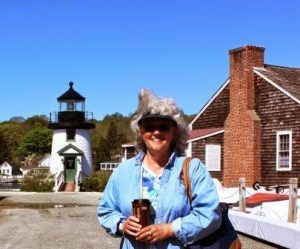
Elinor DeWire at Mystic Seaport Museum. Photo by Dr. Scott DeWire
Elinor DeWire is an author, speaker, historian, and educator based in Connecticut. She has written more than twenty books on various topics, including lighthouses, weather, and amateur astronomy. She also writes novels under her pen name, J.J. Scott. She has received numerous literary and public service awards for her work. She serves on the Board of Directors for the U.S. Lighthouse Society. Visit her website at www.ElinorDeWire.com.
“Turn your ear to me, come quickly to my rescue; be my rock of refuge, a strong fortress to save me.” Psalm 31:2
August 24, 2019
The Perfect Place to Live
More than twenty lighthouse keepers and assistant keepers served at the Galloo Island Lighthouse from the time of its first lighting in 1820 until its automation in 1963. But the one who served the longest was Robert C. Graves, whose tenure spanned thirty years, first as an assistant keeper in 1903, then as the head keeper until 1933.
Galloo Island Lighthouse sits on the southern tip of Galloo Island to mark a group of islands in Lake Ontario for ships en route to either the St. Lawrence River or Sackets Harbor, New York. The 2300-acre island provided plenty of room for the keepers to have livestock, grow gardens, and raise a family.
In August 1923, a reporter wrote of the island, “The beauty and immaculateness of the grounds, and the different varieties of flowers in bloom at this season, showing the care of the nature- loving ones living there; also the little bird houses erected there … show there is one spot on God’s earth where fear is banished and the cattle and birds come to their call. These sights are memories that will linger long in the visitor’s mind … a sort of sacred place that God has set apart and placed this great lamp to be tended by a master hand and to guide his own through troubled waters to safe harbors.”
From the reporter’s point of view, the island was lovely and serene, perfect even. However, the reporter did not live there as the keepers did during the winter months when the lake froze over and transportation came to a halt. Most lighthouse keepers on the Great Lakes went back to the mainland to wait out the season, such as Keeper Graves’ assistants. But the Graves family opted to stay on the island, a decision that kept them isolated from the rest of civilization. Those were the most trying times for the family whose only contact with the outside world was the radio, although most of the stations were from Canada and broadcast in French, which the Graves did not understand.
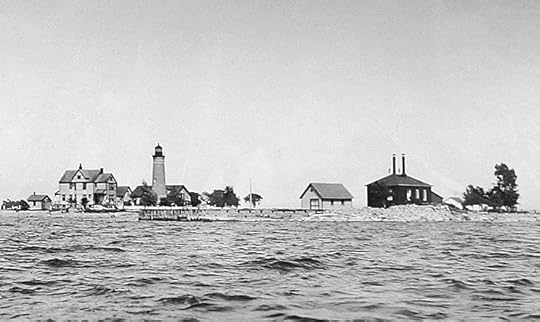
Galloo Island Lighthouse with fog signal, other buildings, 1911, courtesy National Archives
Although the family stocked up as much as possible, Keeper Graves still made occasional, often dangerous trips to the mainland across the ice. When the ice was thick, he took horse-drawn sleighs, but when the ice began to thin and break apart, he had to walk the twenty miles in frigid temperatures and gusty wind. His wife never knew exactly when he’d return, but prayed he would, and despite some close calls, he did.

Galloo Island Lighthouse, 1911, courtesy US Coast Guard
Galloo Island was not a perfect place; in fact, it had its challenges. Many people wouldn’t have enjoyed year-round living on the remote island. But the island was where the Graves family wanted to live.It’s interesting to note that the perception of life on the island could vary from one person to the next.
Living on a beautiful island where everything is blooming is appealing to many, but isolated for five months on a frozen, barren island isn’t very attractive.
So why would people like the Graves family want to endure it? I believe their attitude made the difference. They knew the difficult months would come and they’d have to endure them, and so they did. They also knew the good months would come when the bad months ended, which gave them something to look forward to. They accepted the challenging times in order to enjoy the pleasant times.
We also have the ability to change our outlook by changing our attitude. All we have to do is decide to be content with whatever situation we’re in.
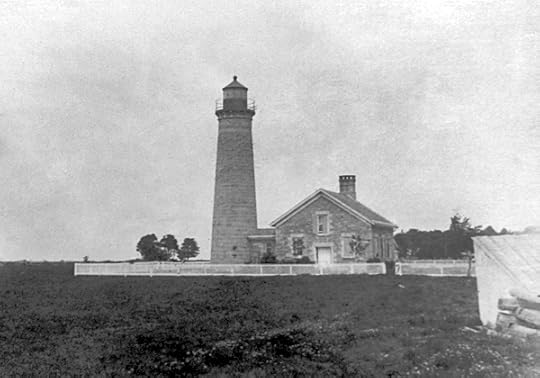
Galloo Island Lighthouse, 1885, courtesy National Archives
The apostle Paul said he’d discovered the secret to changing his attitude. He said, “I know what it is to be in need, and I know what it is to have plenty. I have learned the secret of being content in any and every situation, whether well fed or hungry, whether living in plenty or in want. I can do all this through Him who gives me strength.” (Philippians 4:12-13)
*For more information about Robert Graves, see the July-August 2019 issue of Lighthouse Digest.
July 4, 2019
Happy 4th of July!
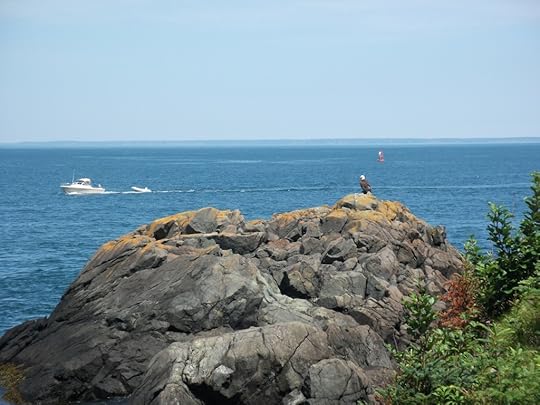
This land is my land.
Little River Island, Cutler, Maine
Photo by Chuck Turk, July 2013
“Good Morning, Baldy,” the lighthouse said as the island’s resident male eagle did a flyby.
“Morning, Flash,” Baldy responded. “Beautiful day.”
“What have you been doing – fishing?”
“Earlier.” The eagle landed on a rock beside the water. “Had to get breakfast to the nest for the youngster. But I’ve spent the last couple of hours just flying all around – looking down on town, the harbor and the water. Lots of people out today.”
“Ah yes. It’s a special day. I’m even going to put on my special attire to celebrate.”
“So why’s today so special?” Baldy watched a boat pass by.
“4th of July – America’s Independence Day,” the lighthouse said.
“They really like to celebrate it. I saw a parade downtown with everyone waving little flags. And I saw lots of people setting up for picnics.”
“Yep. It’s quite a day. I expect to see some folks over here on the island as well,” Flash added.
“It’s amazing how many boats are out – sailboats, lobster boats, motorboats, even kayaks. So what are they celebrating about that day?”
“Freedom. Freedom to live in this country and enjoy life, liberty and the pursuit of happiness.”
“Didn’t our Creator give everyone those gifts?” Baldy cocked his head.
“He did. He gave the people their freedom, and many of them have gone to battle to guarantee they keep it.”
“So that’s why they’re all out here having fun?”
“Yep. Because they can.”
“Now the Lord is the Spirit, and where the Spirit of the Lord is, there is freedom.” 2 Corinthians 3:17
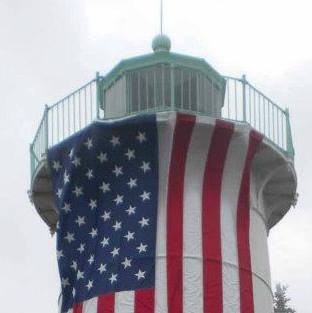
Little River Lighthouse, Maine, Photo courtesy Lighthouse Digest
May God continue to bless America. Have a wonderful 4th of July!
June 23, 2019
The Lighthouse Keepers’ Lifeline
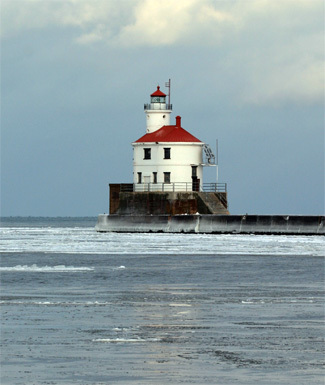
Wisconsin Point (Superior Entry) Lighthouse, Photo courtesy lighthousefriends.com.
November, 1970
Lake Superior was at its worst, with winds of 70 m.p.h. blowing icy waves over the Wisconsin Point Lighthouse and shaking the concrete building.
Although the U.S. Coast Guard keepers’ main dwelling was on the mainland, the lighthouse was equipped with a kitchen, living room, three bedrooms and a bathroom on the second floor. These living quarters were used so the keepers didn’t have to go back and forth twice a day from the mainland. Most of the time, the keepers reached the lighthouse by boat instead of walking out the 500-yard-long breakwater.
But this storm had gone on for two days and two young guardsmen. Robert Dunno and Fred Ketola, were stranded at the lighthouse. Wind and waves had crashed through windows twenty feet high and sent spray over the top of the seventy-foot lighthouse, and water was slowly filling the lower level. The radio beacon equipment was ruined, the power was out, and the backup generator provided little heat and light. Their food supplies were low, and their fresh water was almost gone.
The keepers consumed their last meal with provisions boiled in lake water and faced the necessity of leaving, or they would starve and freeze to death. So on November 28, they left the confines of the lighthouse and ventured out onto the ice-covered breakwater knowing how dangerous the effort would be to reach the mainland. Neither man wore a life jacket as they faced winds and wave that could sweep them away.
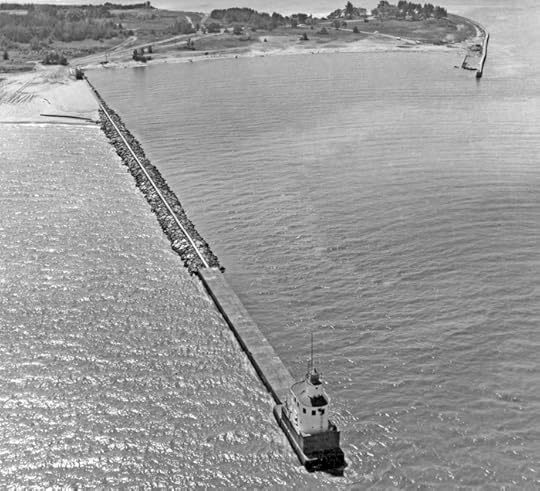
Wisconsin Point (Superior Entry) lighthouse at end of breakwater. Photo courtesy USCG archives
At first, they were able to hold onto the railing posts in the concrete, but after that they were forced to lie on their stomachs and crawl across the breakwater as they were lashed by wind and soaked by waves. They had not gotten very far when a strong gust of wind literally blew Fred Ketola off the breakwater and onto the rocks, just inches above the frigid lake. Robert Dunno reached down and grabbed Fred’s arm, pulling him back up.
Meanwhile, head keeper David Simonson had seen the men struggling and had taken line from shore and crawled onto the rocks, securing the line halfway out on the breakwater. The other end was securely held by another coast guardsman on shore. Ketola and Dunno slowly made their way to the halfway point where they reached the lifeline and grasping it, were carefully guided back to shore, thankful to be alive. Blue from the cold and their clothes frozen from the icy seaspray, the men finally reached the comfort and safety of the warm keepers’ house.
Without the lifeline the head keeper brought out to the men, they might not have made it back.
The story made me think of times I’ve been struggling, and someone had handed me a “lifeline” to pull me through. Sometimes it was a phone call from a friend when I felt all alone. Other times, someone helped me by providing something I needed.
But we have other lifelines available as well. Turning to God in prayer and reading His Word in the Bible has given me the relief and reassurance I sought. I am so thankful to have these lifelines to guide me. Do you have a lifeline?
We who have run for our very lives to God have every reason to grab the promised hope with both hands and never let go. It’s an unbreakable spiritual lifeline, reaching past all appearances right to the very presence of God… — Hebrews 6:18-19 The Message
June 20, 2019
18 Common Words & What you can use instead, a nifty tool from GrammarCheck.net
December 25, 2018
A Greater Light
“The people walking in darkness have seen a great light.” Isaiah 9:2
The light of the world has come!
Merry Christmas!

